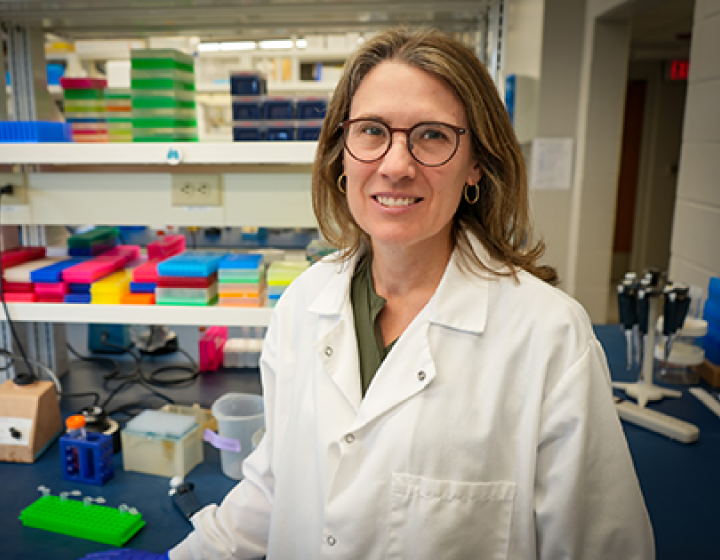Tracking the mystery of the immune system
Infants are extremely susceptible to infections and diseases. Not only do they easily catch viruses like respiratory syncytial virus (RSV) and parainfluenza, but they can become reinfected with the same pathogen. Neonates — infants up to 28 days old — are especially vulnerable. Generally, the explanation for this centers around the idea that a newborn’s immune system is immature. In contrast, the immune system of a healthy adult learns how to defeat a pathogen and then is able to recognize and fight off the same pathogen if it shows up again.
“I was really curious why there is this age-related difference in immune response,” said Dr. Brian Rudd, associate professor in the Department of Microbiology and Immunology at the College of Veterinary Medicine. “So some years ago, my lab designed a series of studies to see whether it had something to do with the neonatal environment or with the neonatal immune cells themselves.”
Rudd and his collaborators looked at cytotoxic T cells, also called CD8 T cells. These are frontline components of the immune system — white blood cells that kill other cells infected with intracellular pathogens, such as viruses or bacteria. Some T cells also turn into memory cells, able to remember pathogens they’ve already encountered and mount an attack if they run into them again.
“We found that neonatal T cells actually respond more quickly to a pathogen than adult cells do,” Rudd said. “But they fail to transition into long-lived memory cells. The reason isn’t because they are defective or impaired, but rather because they proliferate and differentiate more quickly than their adult counterparts. Neonates actually seem to have an immune system that works more efficiently in some ways, but the efficiency comes at the expense of memory.”
Fetal T cells lead the attack
The Rudd lab continued to pursue research aiming to uncover the underlying basis for this difference between infant and adult immune responses. The researchers looked at the origin of neonatal versus adult T cells. All T cells are made in the thymus from stem cells. In adults, those stem cells come from bone marrow, but Rudd and his colleagues discovered that neonatal T cells are derived from fetal liver progenitor cells and retain their cell intrinsic properties as they persist into adulthood.
“This was a big discovery,” Rudd said. “Those first fetal T cells that are made are actually the first cells to respond to infection in adulthood. They generate a rapid response to protect against a pathogen. The T cells made later in life from adult bone marrow don’t get recruited as quickly into the immune response as the neonatal-derived cells, but they have an increased potential to go on and form memory to protect against reinfection.”
This finding sparked a new way of thinking about immune system development, Rudd explained. “Prior to our work, everyone thought that all cell fate decisions were made after infection and that the starting pool of T cells was homogenous,” he said. “But we showed that there are actually developmental layers in the T cell response to infection. The fates of cells, the way they respond, is linked to when they were initially created in the body.”
Building on this work, Rudd wondered what determines the ratio of fetal- versus adult-derived cells present in an organism’s starting pool of T cells. Could the composition of the starting pool be responsible for the effectiveness of an immune system’s response?
“We already know, for example, that people have different propensities for developing autoimmune diseases and allergies, which are both connected to problems with the immune system,” Rudd said. “But no one understands the underlying mechanism. Does where you grow up affect your susceptibility to these types of immune system issues? For instance, does it matter whether you grow up on a farm or in the city?”
More microbes means more immunity
Using mouse models, the researchers compared the composition of T cells in animals born and raised in a laboratory environment that is hyper clean and essentially pathogen-free, versus those raised in a pet shop — or “dirty-mouse” — environment, which appears clean but is teeming with normal mouse pathogens.
The immune systems that resulted from the two environmental models were completely different, Rudd said. “Mouse models that grew up in the ‘dirty’ environment were highly resistant to infection,” he said. “The reason for this is that they have a larger starting number of fast-acting, fetal-derived T cells. The underlying basis for the enhanced immune protection has to do with changes in the developmental layering of T cells in the immune system.”
The dirty-mouse models were exposed to a higher number of microbes in their environment once they were born. This could be one explanation for their higher number of fetal-derived T cells, which would have been created soon after birth. Yet Rudd and his colleagues found that much of the immune system programming actually happened before birth. “It has to do with the mother being exposed to microbes before the pups are born,” he said. “Right now, we’re attributing the increased resistance to infection in the dirty-mouse model to a more microbial-diverse environment. But we haven’t worked out yet what those pathogens actually do to alter the development of the immune system.”
Rudd is planning future research projects with Dr. Ilana Brito, associate professor in the College of Engineering and the Mong Family Sesquicentennial Faculty Fellow in Biomedical Engineering, and other colleagues to pinpoint the factors in the environment that contribute to the creation of T cells before and immediately after birth.
Written by Jackie Swift for Cornell Research & Innovation






